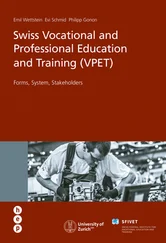
Markus Maurer, Silke Fischer, Karin Hauser
The Swiss Model of Vocational Education and Training
System and Pedagogical Approaches
Didaktische Hausapotheke, volume 7
ISBN print: 978-3-0355-0278-7
ISBN e-book: 978-3-0355-0300-5
Cover picture: Rafael Heuri
First Edition printed in 2017
All rights reserved
© 2017 hep verlag ag, Berne
www.hep-verlag.com
Table of contents
Foreword by Rudolf Strahm Foreword by Rudolf Strahm The high rate of youth unemployment, up to 20 or even 30% in many countries, is a social and economic problem of great concern. Unemployment at such an early stage in life is a humiliating experience for young people: instead of being able to start a career, school leavers and university graduates feel as though they are absolutely no use to society whatsoever. The challenge may become greater in the near future: according to a recent UN forecast, more than 600 million new jobs will be required over the next decade to provide school leavers with a perspective in the labour market. Vocational education and training (VET) plays an important role in the transition of young people into the world of work, and policy makers in different parts of the world have, therefore, started reforms to strengthen it: many of them are looking at countries with dual-track VET. This form of VET combines company-based apprenticeships (with a special type of employment contract) with school-based learning, which is one of the reasons why these countries have comparatively low rates of youth unemployment. Dual-track VET is a particularly effective way of acquiring both practical vocational skills and theoretical know-how. Practical intelligence and cognitive, theory-oriented intelligence thereby reinforce each other. In Switzerland, two thirds of all young people start their career with dual-track VET lasting two to four years. With their VET qualification and the skills they have developed they are fully employable. Nevertheless, a growing number of VET graduates subsequently participate in some type of tertiary education, be it at a PET college, a university of applied science or a regular university. Given the interest of many countries in dual-track VET systems, there is a need for publications that provide a broad overview of these systems. This book explains – in a highly accessible way – both the systemic elements as well as the key pedagogical approaches upon which the Swiss model of vocational education and training is based. Rudolf H. Strahm, Dr h. c. Former Swiss Member of Parliament/Former Price Supervisor of the Swiss Confederation Lecturer in Professional and Vocational Education, Universities of Berne and Fribourg
Foreword by the editor Foreword by the editor Dear readers This book is part of a series edited by the Zurich University of Teacher Education (PH Zurich) that is dedicated to the essentials of teaching and learning and has a specific focus on vocational education and training. All books in the series present their contents in a highly condensed way, in order to be easily accessible by teachers, instructors and other professionals involved in education and training. Whereas other books in this series are dedicated to issues that are closer to the classroom, this contribution covers the more underlying systemic elements of teaching and learning in Swiss vocational education and training (VET). It is addressed, on the one hand, to all those in Switzerland who look for information in English that can help them to present key features of Swiss VET abroad. On the other hand, it also addresses VET professionals from other countries who want to better understand our country’s approach to prepare learners at upper secondary level for the world of work. In contrast to other existing publications on Swiss VET in English, this one – while discussing systemic elements in depth – pays additional attention to underlying pedagogical concepts and provides readers with a number of concrete examples. This publication in English also expresses our university’s dedication to deepen our cooperation with international partners. Given the growing interest in the Swiss VET model, our university already now plays a role in providing expertise to other countries that are interested in improving their VET systems. Although we are convinced of the many advantages of the system that is portrayed in this book, we are equally convinced that reforms of other VET systems cannot rely on simply importing models from abroad. Rather, such reforms need to be based on a serious understanding of how the education system and the labour market interact in the particular context, on sound political judgement and on a solid approach to implementation. It is in this way, at least, that VET in Switzerland has been evolving. Prof. Christoph Städeli Head of the Department of Upper Secondary Education, PH Zurich Editor-in-chief of the series
Abbreviations
1Why this book? 1Why this book? In recent years, international interest in the Swiss system of vocational education and training (VET) has grown. Key reasons for this are: VET is very important in Swiss education and training, and the system design has some striking features; and the country’s low rate of youth unemployment is seen by many to be a result of the country’s VET system. In line with this growing interest, the English literature on Swiss VET in English has also been growing. Apart from publications for a mainly academic audience that cover different aspects of Swiss VET, most other English publications focus on the system. In this book, however, we aim to cover both systemic and pedagogical aspects of Swiss VET but obviously in very condensed format. The focus here is on dual-track VET. School-based VET and professional education and training (PET) are covered only very briefly. In all those cases, where we focus on the overall system, we make use of the term ‘vocational and professional education and training’ (VPET) that has become somewhat common in English literature on Swiss VET. In the preparation of this book, some publications have been of particular importance. For the current terminology and data on Swiss VET, the SERI’s (2016) ‘Facts and Figures’ publication on Swiss VPET (updated on a yearly basis) and the database of the Federal Statistical Office were enormously helpful. Data and other information from these two sources are cited without explicit reference in the text. We also would like to direct readers of this book to the rich online VPET-glossary by the SDBB, which is in large part also available in English, 1 as well as to the comprehensive work by Wettstein, Schmid and Gonon (2014) on Swiss VPET.
2Key characteristics of Swiss VET 2Key characteristics of Swiss VET Swiss VET consists of different programmes at the upper secondary level (ISCED level 3). From an international perspective, three characteristics of Swiss VET are clearly most important: →VET as the predominant form of education at the upper secondary level Looking at all new entrants to upper secondary education, a large majority of them (72% in 2013) start a VET programme. If one focuses only on the qualifications achieved at this level of education, the VET share is even higher (76% in 2013). 2 →Dual-track VET as the predominant type of VET Though school-based VET plays a certain role, more than 85% of VET students at the upper secondary level enrol in dual-track VET. This implies that they undergo apprenticeship training at a host company – accounting for the majority of total time spent in VET – and go to school part-time, in many cases 1 to 1.5 days per week. The pervasive role of dual-track VET is only possible thanks to those approx. 40% of all companies in the Swiss economy that get involved in training VET students. →Broad range of occupations At upper secondary level, there are VET programmes in approx. 230 occupations which prepare students to achieve two types of VET qualification (i.e. VET certificate and VET diploma). These programmes cover all sectors of the Swiss economy – including construction, engineering, health and social sectors, and banking – and they are designed in strong cooperation with the representatives of these sectors. The programmes cater for all kinds of students (including high achievers) who enrol in the more demanding programmes (and also have the option of passing the Swiss Federal Vocational Baccalaureate), as well as those who have difficulties at school. Still, only ten occupations account for over 50% of all entrants into upper secondary VET. Work-based learning of a VET student in a large mechanical engineering company
Читать дальше













